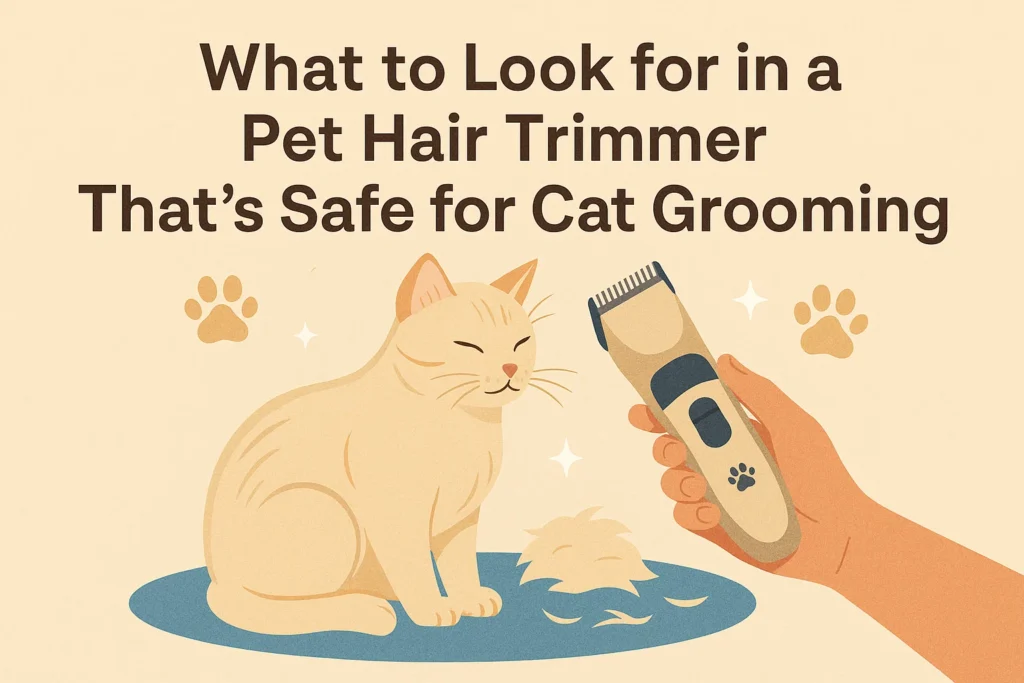Cats may be masters of self-grooming, but that doesn’t mean they don’t need our help sometimes. Long-haired breeds, older cats, or felines prone to mats and tangles benefit greatly from regular trimming. The tricky part? Finding a pet hair trimmer that’s actually safe—and comfortable—for grooming cats.
Unlike dogs, cats are typically more sensitive to noise, vibration, and touch. That’s why choosing the right grooming tool is more than just a matter of preference; it’s about your cat’s well-being. In this article, we’ll walk you through what features truly matter when selecting a cat hair trimmer, and how to make grooming a stress-free experience for both of you.
Why Not Just Use Any Pet Hair Trimmer on a Cat?
It’s tempting to think one size fits all when it comes to grooming tools. But cats have finer, softer fur and more delicate skin than many other pets. A trimmer that works for a dog’s coarse coat may pull or irritate a cat’s fur. That’s why using a cat hair trimmer designed with feline grooming in mind is essential.
The right trimmer minimizes discomfort, reduces noise, and handles sensitive areas—like around the ears, belly, and tail—with ease.
1. Low Noise and Vibration: Less Stress for Sensitive Cats
Cats have sharp sens
What to Look For:
es. Even a moderate buzzing sound can send them running. A high-pitched or vibrating pet hair trimmer can cause stress, especially in nervous or older cats.
- Quiet motor (preferably under 60 dB)
- Low vibration levels
- Smooth operation for calm trimming sessions
A quieter grooming tool helps create a more relaxed environment, making it more likely your cat will sit still and tolerate the process.
2. Safe, Rounded Blades That Won’t Nick the Skin
Sharp, exposed blades are a big no-no when it comes to grooming pets—especially cats. Their skin is thinner and more elastic than a dog’s, making it more vulnerable to nicks and cuts if you’re not careful.
What to Look For:
- Rounded blade tips
- Skin-friendly, ceramic or stainless-steel blades
- Guards or comb attachments for sensitive areas
A good cat hair trimmer will glide gently over the skin, cutting the fur without pulling or irritating your cat’s coat.
3. Adjustable Speeds and Blade Settings
Every cat is different. Some have thick double coats that need more power; others have fine fur that requires a gentle touch. Having control over trimming speed can make a big difference, especially for beginners.
What to Look For:
- Multiple speed settings (usually 2–3 options)
- Adjustable blade lengths for different fur types
- Easy-to-use controls and switches
Using the right speed ensures an even trim without overheating the blade or startling your cat with sudden movements.
4. Cordless Convenience and Rechargeable Power
Cats don’t always stay in one place for long, and cords can get in the way during grooming. A cordless pet hair trimmer gives you more freedom to move around and reach difficult spots without stressing your cat.
What to Look For:
- Long-lasting battery (60–90 minutes of runtime is ideal)
- USB or fast charging options
- Lightweight design for easy handling
Cordless models are especially helpful for grooming hard-to-reach areas like the belly or under the legs, where cats can get squirmy.
5. Easy Maintenance and Quiet Operation
Clean tools are safe tools. A quality cat hair trimmer should be easy to clean after each use to avoid clogged blades or bacterial buildup.
What to Look For:
- Detachable blades for cleaning
- Included brush or cleaning tool
- Waterproof or water-resistant design (optional but helpful)
If the trimmer also operates quietly during cleaning and recharging, that’s an added bonus—especially if your cat is nearby.
6. Compact Size and Ergonomic Design
Grooming a cat is often a delicate task. Bulky, heavy clippers can make it difficult to maneuver around the face, paws, or tail. You want a pet hair trimmer that feels good in your hand and doesn’t tire you out.
What to Look For:
- Slim, ergonomic grip
- Lightweight body
- Non-slip or textured handle
A well-balanced tool allows for more precise grooming, which is especially important for trimming around sensitive spots.
7. Designed Specifically for Cats or Small Pets
Though many trimmers are labeled as general-purpose, it’s best to select one made with cat hair trimmer features in mind. Cats require more finesse than larger pets when it comes to grooming.
What to Look For:
- Designed for cats or small breeds
- Specialized blade attachments for small areas
- Trimmer kits with accessories for ears, paws, or whiskers
While multi-pet use is common, a trimmer with cat-specific attachments helps avoid overcutting or irritating your cat’s skin.
Read: Pet Grooming on a Budget | Best Low-Cost Pet Hair Trimmer for Paws
Tips for a Smooth Grooming Session
Choosing the right pet hair trimmer is only half the battle. Knowing how to approach grooming can make all the difference.
- Start slow: Let your cat sniff the trimmer before turning it on.
- Pick the right time: Groom when your cat is calm—not after playtime or meals.
- Use treats: Reward your cat before and after grooming to build positive associations.
- Stay calm: Cats sense your energy. Stay relaxed and patient.
If your cat is new to grooming, consider trimming in short sessions until they adjust. Building trust is key.
FAQs
Q1: Can I use a dog hair trimmer for my cat?
While some trimmers are suitable for both dogs and cats, it’s better to choose one specifically designed for cats due to their more delicate skin and thinner fur.
Q2: How often should I trim my cat’s fur?
It depends on the breed. Long-haired cats may need trimming every 4–6 weeks, while short-haired cats might only need occasional touch-ups.
Q3: Are there any areas I should avoid trimming?
Yes, avoid trimming around sensitive areas like whiskers, eyes, and genital regions unless absolutely necessary and you’re confident in doing it safely.
Q4: What should I do if my cat is scared of the trimmer?
Introduce the trimmer slowly. Let them sniff it while it’s off, then turn it on nearby to get them used to the sound before actual grooming.
Q5: Should I bathe my cat before trimming?
It’s a good idea to brush and possibly bathe your cat before trimming. Clean fur is easier to trim and prevents the blades from clogging.
Conclusion
When it comes to grooming, cats deserve more than a one-size-fits-all tool. A thoughtfully designed pet hair trimmer—one that takes into account a cat’s sensitivity, size, and grooming needs—can turn an often stressful task into a peaceful, productive experience.
The right cat hair trimmer offers precision, comfort, and control, helping your cat look and feel their best without fear or fuss. With a little care and the right equipment, grooming time can become a bonding moment instead of a dreaded chore.
After all, grooming isn’t just about appearance—it’s about health, hygiene, and happiness for your feline companion.


